Home » Jazz Articles » Album Review » Steve Lacy: The Beat Suite
Steve Lacy: The Beat Suite
Steve Lacy, under the influence of the great New Orleans altoist Sidney Bechet, started his musical journey playing Dixieland back in the early fifties, but moved quickly into the realm of avant-garde, playing with pianist Cecil Taylor from 1955-57. In a nearly fifty-year career, he has made more than eighty recordings as a leader; but thirty-plus years of living in Europe—recording on small labels there—has kept his US profile lower than it should be.
The soprano saxophone, eschewed by much of the jazz world from swing through bebop, is a notoriously tough horn to master; but Lacy is an unparalleled talent on the "straight horn." His tone on The Beat Suite is rich, smooth and beautifully controlled, while the overall feel of the disc is closer to his Dixieland roots than his later more avant-garde sound or his Monk tributes. The swirling mix of his alto and George Lewis's vibrant trombone weave sinuous New Orleans lines around the front horn: the voice of Irene Aebi.
Aebi is a long-term musical collaborator of Lacy's, as well as his wife of thirty-plus years. Her voice has been described as an acquired taste. It is a singular instrument—joyous histrionics, completely channeled to the task at hand, from this viewpoint. Her horn-like tone seems a gorgeous amalgam of trumpet and clarinet, a sound that adds to the Dixieland atmosphere of the disc, with much of the music consisting of her singing accompanied by slaloming trombone and alto.
But from the angle of the words of the Beats, she might as well be scatting. For better or worse, the lyrics are all but indecipherable. For my taste, her tone and delivery are so compelling that it matters not. (The poems are printed in the cover booklet for those who are interested, and Gregory Corso's "The Mad Yak" is a grim, surreal gem.) The three horns dance together, an ebullient sound. Lewis on trombone growls and snarls at times; Lacy's clean lines have a purity and simplicity; and the rock-solid but inobtrusive bass/drum team—Jean Jaques Avenal and John Betsch—help keep the sound anchored to the more traditional end of the spectrum, while Aebi chortles, trills and at times comes close to yodeling.
Lacy says: "This is highfalutin' material. It's not for everybody." Maybe he's right. The sound could certainly scare off a neophyte jazz fan, but for anyone who has done some serious listening, the roots of this music lie deep in tradition, and The Beat Suite is one of Steve Lacy's most purely beautiful sets.
Track Listing
Wave Lover, Song, Naked Lunch, Private Sadness, A Ring of Bone, The Mad Yak, Jack's Blues, Agenda, In the Pocket, Mother Goose
Personnel
Steve Lacy
saxophone, sopranoSteve Lacy, alto saxophone; Irene Aebi, voice; Geroge Lewis, trombone; Jean Jacques Avenel, bass; John Betsch, drums
Album information
Title: The Beat Suite | Year Released: 2003 | Record Label: Universal Music Group
< Previous
Couldn
Comments
Tags
For the Love of Jazz
 All About Jazz has been a pillar of jazz since 1995, championing it as an art form and, more importantly, supporting the musicians who create it. Our enduring commitment has made "AAJ" one of the most culturally important websites of its kind, read by hundreds of thousands of fans, musicians and industry figures every month.
All About Jazz has been a pillar of jazz since 1995, championing it as an art form and, more importantly, supporting the musicians who create it. Our enduring commitment has made "AAJ" one of the most culturally important websites of its kind, read by hundreds of thousands of fans, musicians and industry figures every month.




















